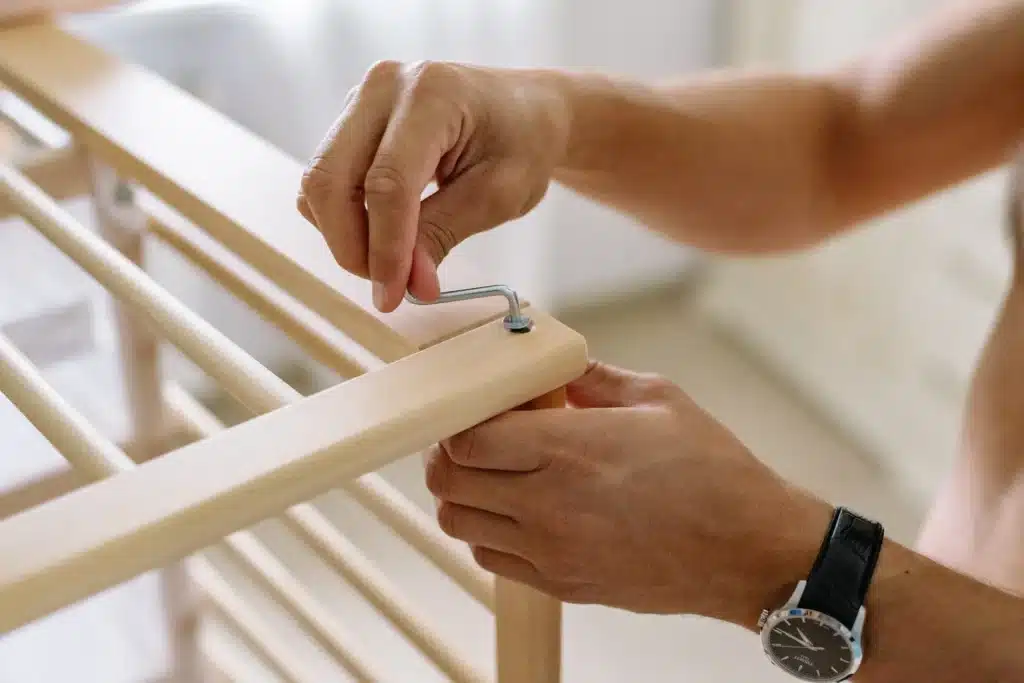
Moving homes is a significant event in anyone’s life. It’s not just about changing your address; it’s about ensuring that all your belongings, especially your furniture, make the journey safely. One of the most challenging aspects of moving is dealing with large, bulky furniture. Furniture Disassembly while relocating is not just a choice; it’s often a necessity. This article delves into the art of disassembling furniture for easier relocation, offering insights, tips, and expert advice to make your move as smooth as possible.
Table of Contents
ToggleThe Process of Furniture Disassembly
Disassembling furniture can seem daunting, especially if you’re unfamiliar with the process. However, with the right approach and tools, you can efficiently break down even the most intricate pieces. Here’s a comprehensive guide to the furniture disassembly process.
1. Preparation:
- Assessment: Before diving in, assess the furniture piece. Determine which parts are detachable and identify the type of fasteners (screws, bolts, etc.) used.
- Gather Tools: Based on your assessment, gather the necessary tools. Commonly required tools include screwdrivers, wrenches, pliers, and Allen keys.
- Safety First: Ensure you’re working in a well-lit space. Wear protective gloves to prevent splinters or scratches, and consider safety goggles if there’s a risk of flying debris.
2. Start with Detachable Components:
- Drawers and Shelves: Begin by removing any drawers or adjustable shelves. For drawers, open them fully, locate the catch or lever that prevents them from falling out, and then gently pull them out.
- Cushions and Padding: For sofas or chairs, remove any detachable cushions or padding.
3. Disassemble the Main Frame:
- Loosen Fasteners: Using the appropriate tool, start loosening the screws, bolts, or other fasteners. Turn counterclockwise to unscrew. Remember to keep all fasteners in labeled bags for easy reassembly.
- Gentle Force: If a component seems stuck, gently wiggle it to loosen. Avoid using excessive force, which could damage the furniture.
- Labeling: As you disassemble, use masking tape and a marker to label parts, especially if they look similar. This will aid in the reassembly process.
4. Handle Special Components with Care:
- Glass Elements: If the furniture has glass components, handle with extreme care. Wrap them in bubble wrap or thick blankets for added protection during the move.
- Mechanical or Electrical Parts: For furniture with mechanical or electrical components, such as reclining chairs, refer to the user manual for disassembly instructions. Ensure all electrical connections are unplugged before starting.
5. Organize and Store:
- Keep Small Parts Together: Use zip-lock bags or small containers to store screws, bolts, and other small components. Label each bag clearly, indicating which part of the furniture it belongs to.
- Wrap Larger Parts: Use moving blankets, bubble wrap, or old sheets to wrap larger furniture parts. This protects them from scratches and dents during the move.
- Documentation: If you’ve taken photos or made notes during the disassembly process, keep them with the furniture components. They’ll be invaluable during reassembly.
While furniture disassembly requires patience and attention to detail, it’s a manageable task with the right preparation. By following a systematic approach and prioritizing the safety of both the furniture and yourself, you can ensure that your pieces are ready for relocation and will be just as sturdy and beautiful when reassembled in their new home.
Tool Kits Essential for Furniture Disassembly
Having the right tools can make the process of furniture disassembly smooth and efficient. Whether you’re a DIY enthusiast or just looking to save on moving costs, having a toolkit ready can be immensely helpful.
Essential Tools for Furniture Disassembly:
- Screwdrivers: A set of both flat-head and Phillips screwdrivers is crucial. Different furniture pieces may use various types of screws, so having a diverse set is beneficial.
- Wrench Set: Wrenches are essential for loosening and tightening bolts. An adjustable wrench can be particularly handy as it fits various bolt sizes.
- Hammer: While primarily used for nails, a hammer can also be useful for gently tapping parts to loosen them.
- Allen Wrench (Hex Key): Many furniture pieces, especially flat-pack items, use Allen bolts. Having a set of Allen wrenches in different sizes is essential.
- Pliers: Useful for gripping, bending, or cutting wires, pliers are a versatile tool to have in your kit.
- Tape Measure: Before disassembly, measure your furniture to ensure it will fit in its new location. A tape measure can also be useful for spacing out furniture in your new home.
Organizing Your Toolkit:
- Storage Box: Keep your tools in a dedicated storage box or bag. This ensures they’re always on hand when needed and prevents loss.
- Labeling: If you’re dealing with multiple furniture pieces, use labels to keep track of which screws or bolts belong to which item.
- Safety First: Always ensure your tools are in good condition. Regularly check for any signs of wear or damage. Also, keep them out of reach of children.
Importance of Labeling and Organizing During Disassembly
The process of disassembling furniture can quickly become chaotic without proper organization. Labeling and systematic organization are paramount to ensure a smooth reassembly process at your new location.
Why Labeling Matters:
- Identification: With multiple furniture pieces disassembled, it can be challenging to determine which screws, bolts, or parts belong to which item. Proper labeling eliminates this confusion.
- Efficiency: When reassembling, having labeled parts can significantly speed up the process. You won’t waste time searching or trying to figure out which component fits where.
- Reduction of Loss: Small parts can easily get misplaced during a move. By keeping them labeled and organized in bags or containers, the risk of loss is minimized.
Steps for Effective Labeling:
- Photograph Before Disassembly: Before you start taking apart any furniture, take clear photos from multiple angles. These images will serve as a reference during reassembly.
- Use Zip-lock Bags: For small components like screws, nails, or bolts, use zip-lock bags. They’re transparent, allowing you to see the contents, and can be easily sealed.
- Label Clearly: Use a permanent marker to label each bag or container. Indicate which furniture piece the components belong to and, if possible, where they fit (e.g., “Dining Table – Leg Bolts”).
- Tape Bags to Larger Parts: For convenience, you can tape the zip-lock bags to larger disassembled parts of the furniture. This ensures that everything stays together.
Safety Precautions During Furniture Disassembly and Moving
Safety should always be at the forefront of any moving process. Whether you’re disassembling furniture, packing boxes, or loading a moving truck, taking precautions can prevent injuries and damages.
General Safety Tips:
- Dress Appropriately: Wear comfortable clothing that doesn’t restrict movement. Closed-toe shoes with good grip are essential to prevent slips and falls.
- Lift Properly: Always lift with your legs, not your back. When picking up heavy items, bend at the knees and keep the item close to your body.
- Avoid Overloading: Whether it’s a moving box or a dolly, avoid overloading. It’s better to make a few extra trips than risk injury.
- Stay Hydrated: Moving is physically demanding. Drink plenty of water throughout the day, especially if you’re moving in hot weather.
Furniture Disassembly Safety:
- Use the Right Tools: Always use the appropriate tool for the task. This not only makes the job easier but also safer.
- Work in a Well-Lit Area: Ensure you have good lighting when disassembling furniture. This helps you see what you’re doing and reduces the risk of mistakes.
- Keep Children and Pets Away: The disassembly area should be off-limits to children and pets. They can easily get hurt or become a distraction.
Moving Day Safety:
- Have a First Aid Kit: Accidents can happen. Having a first aid kit on hand ensures that minor injuries can be treated immediately.
- Use Gloves: Protective gloves can prevent splinters, cuts, and provide a better grip on items.
Communicate: If you’re moving with others, communication is key. Whether you’re lifting a heavy item or navigating stairs, always let others know your intentions.
Packing Services and Their Importance
Packing is an integral part of the relocation process. Proper packing ensures that your belongings, especially furniture, are protected during transit.
Benefits of Professional Packing Services:
- Expertise: Professional packers have the knowledge and experience to pack items securely. They understand the nuances of packing different items, from delicate glassware to bulky furniture pieces.
- Materials: Professional packing services use high-quality packing materials. This includes sturdy boxes, bubble wrap, packing peanuts, and specialized covers for furniture.
- Time-saving: Packing can be time-consuming. Professional packers can pack your entire home or office in a fraction of the time it would take you to do it yourself.
- Insurance: Many professional packing services offer insurance. This means that if any of your items are damaged during transit due to improper packing, you’re covered.
DIY Packing Tips:
If you choose to pack yourself, here are some tips to ensure your belongings are packed securely:
- Use the Right Boxes: Use sturdy boxes that are appropriate for the items you’re packing. For instance, use book boxes for books and large boxes for lighter items like linens.
- Protect Fragile Items: Use bubble wrap, packing paper, or towels to wrap fragile items. Ensure they are packed tightly in boxes with no room to move.
- Label Boxes: Clearly label each box, indicating its contents and the room it belongs to. This makes the unpacking process more manageable.
- Disassemble Furniture: As discussed, disassembling furniture makes it easier to move and pack. Ensure all parts are labeled and packed securely.
The Role of Furniture Dollies in Relocation
When it comes to moving heavy furniture, having the right equipment can make a world of difference. One such indispensable tool is the furniture dolly. These simple yet effective devices can transform the daunting task of moving bulky items into a manageable one.
Understanding Furniture Dollies:
A furniture dolly is a platform on wheels designed to transport heavy items. Typically made of wood or metal, it has a flat surface with four swivel wheels for easy maneuverability. Some models come with handles or straps for added control.
Benefits of Using Furniture Dollies:
- Weight Distribution: Dollies evenly distribute the weight of the furniture, reducing the strain on the person moving it.
- Protection: Using a dolly minimizes the risk of dropping or damaging the furniture. It also protects the mover from potential injuries.
- Efficiency: With a dolly, moving heavy items becomes faster. It reduces the number of trips and the amount of manual labor involved.
- Versatility: Furniture dollies aren’t just for furniture. They can be used to move appliances, boxes, and other heavy items.
Safety Tips When Using Furniture Dollies:
- Load Evenly: Ensure that the furniture is centered on the dolly to prevent tipping.
- Secure the Load: Use straps or ropes to secure the item to the dolly, especially if it’s tall or top-heavy.
- Clear the Path: Before moving, ensure that the path is free of obstacles. This includes removing rugs, cords, or any other tripping hazards.
- Use Two People: For especially large or awkward items, it’s beneficial to have one person guiding the dolly while another pushes.
The Process of Furniture Reassembly
Once you’ve successfully moved to your new location, the next challenge is reassembling your furniture. While it might seem like a daunting task, with a systematic approach, you can ensure your furniture is reassembled correctly and safely.
Organizing Parts:
As you disassemble furniture, it’s crucial to organize and label each part. Use zip-lock bags for screws, bolts, and other small components. Label each bag clearly, indicating which furniture piece it belongs to.
Following Instructions:
If you have the original assembly instructions for your furniture, use them for reassembly. If not, take photos during the disassembly process. These photos can serve as a reference, making the reassembly process smoother.
Using the Right Tools:
Ensure you have all the necessary tools on hand before starting the reassembly process. This includes screwdrivers, wrenches, hammers, and any other specific tools required for your furniture pieces.
Safety First:
Just as with disassembly, safety is paramount during reassembly. Ensure your workspace is well-lit. Wear protective gloves to prevent splinters or cuts. If you’re using power tools, always follow the manufacturer’s safety guidelines.
Seeking Professional Help:
If you’re unsure about reassembling a particular piece of furniture, consider seeking professional help. Many moving companies offer reassembly services. They have the expertise and tools to ensure your furniture is reassembled correctly and safely.
Tips for Reassembling Furniture Post-Relocation
Once you’ve settled into your new home, the task of reassembling your furniture awaits. While it might seem daunting, especially after a tiring move, with the right approach, you can get your furniture set up efficiently and correctly.
Preparation is Key:
- Gather Your Tools: Before starting, ensure you have all the necessary tools on hand. This includes screwdrivers, wrenches, hammers, and any other specific tools required for your furniture pieces.
- Refer to Photos and Manuals: If you took photos before disassembling, now’s the time to refer to them. They can provide valuable insights into how the furniture piece should look once assembled. If you have the original assembly manuals, they can be a great resource.
Steps for Efficient Reassembly:
- Lay Out All Parts: Before diving in, lay out all the components of the furniture piece. This gives you a clear view of what you’re working with and ensures no part is missing.
- Start with Larger Components: Begin the reassembly process with the larger parts, gradually working your way to the smaller components. This provides a stable base to work on.
- Don’t Force Parts: If a component doesn’t fit easily, don’t force it. Double-check to ensure you’re fitting it correctly. Forcing parts can lead to damage.
- Tighten All Screws and Bolts: Once the furniture is reassembled, go over it and ensure all screws, bolts, and other fasteners are tightened. This ensures the stability and safety of the furniture.
- Inspect the Furniture: After reassembly, inspect the furniture piece. Ensure it’s stable, and all parts are in their correct places. Test drawers, doors, or any moving parts to ensure they operate smoothly.
The Significance of Proper Furniture Care Before and After Relocation
Furniture, whether it’s a cherished heirloom or a modern piece, represents a significant investment. Proper care before and after relocation ensures that these items remain in optimal condition, retaining their functionality and aesthetic appeal.
Why Furniture Care is Crucial:
- Preservation of Value: Well-maintained furniture retains its value over time. This is especially true for antiques or pieces from renowned designers.
- Aesthetic Appeal: Scratches, dents, or stains can detract from the beauty of furniture. Regular care ensures that these pieces continue to enhance the aesthetics of your living space.
- Functionality: Proper care ensures that furniture remains functional. For instance, a well-maintained recliner will operate smoothly, and a wooden table treated with the right products won’t warp.
Pre-Relocation Care:
- Cleaning: Before moving, thoroughly clean each furniture piece. This not only ensures that you’re not transporting dirt or pests but also allows you to inspect each item for any existing damage.
- Minor Repairs: Address any minor issues, such as tightening loose screws or fixing wobbly legs, before the move. This ensures that the furniture is sturdy and ready for relocation.
- Protection: Use furniture pads, bubble wrap, or moving blankets to protect items during transit. Pay special attention to vulnerable areas like glass surfaces or delicate carvings.
Post-Relocation Care:
- Inspection: Once relocated, inspect each furniture piece for any potential damage incurred during the move. Addressing issues immediately can prevent further deterioration.
- Placement: Consider the placement of furniture in your new home. Avoid placing wooden pieces near radiators or direct sunlight, as this can cause warping or fading. Similarly, leather furniture should be positioned away from direct heat sources to prevent drying or cracking.
- Regular Maintenance: Establish a routine for furniture care in your new home. This includes regular cleaning, periodic polishing or conditioning, and addressing any wear and tear promptly.
Furniture is more than just a functional element in our homes; it’s a reflection of our style, memories, and the life we’ve built. Proper care, especially during pivotal moments like relocation, ensures that these cherished items continue to serve us for years to come.
The Role of a Moving Company in Furniture Disassembly
The decision to relocate, whether it’s across the street or across the country, brings with it a plethora of tasks and responsibilities. One of the most daunting challenges is handling furniture. These pieces, often heavy and cumbersome, can be a logistical nightmare. This is where the expertise of a professional moving company becomes invaluable.
Why Consider Professional Movers?
- Expertise: Professional movers are trained to handle furniture of all shapes, sizes, and weights. Their experience ensures that each piece, whether it’s a delicate antique or a hefty wardrobe, is treated with the care it deserves. They understand the intricacies of disassembling various furniture types, ensuring that no damage occurs during the process.
- Equipment: Moving companies are equipped with specialized tools designed for furniture disassembly. From wrenches to furniture dollies, they have everything needed to dismantle furniture efficiently. This equipment not only speeds up the process but also ensures the safety of both the furniture and the people handling it.
- Time-saving: Time is of the essence during a move. With so many tasks to juggle, having professionals take care of furniture disassembly can be a significant relief. They can quickly and efficiently break down furniture, allowing you to focus on other essential aspects of your move.
- Stress Reduction: Let’s face it, moving is stressful. The mere thought of disassembling a complex furniture piece can be overwhelming. Professional movers alleviate this stress, handling the challenging tasks and ensuring your belongings are safely prepared for transport.
Choosing the Right Moving Company:
It’s essential to select a moving company that aligns with your needs. Research potential movers, read reviews, and get recommendations. Ensure they have experience with furniture disassembly and ask about their process. A reputable moving company will be transparent, providing you with information and peace of mind.
Mastering the Art of Furniture Disassembly and Reassembly
Relocating is more than just a physical transition from one place to another; it’s a journey filled with emotions, memories, and new beginnings. Furniture, being an integral part of our living spaces, carries the essence of our past and paves the way for our future. Ensuring its safe and efficient disassembly and reassembly is paramount, not just for the sake of the furniture itself, but for the memories and value it holds.
While the process might seem intricate, with the right knowledge and tools, anyone can master the art of furniture disassembly. However, it’s essential to approach the task with patience, attention to detail, and a commitment to preserving the integrity of each piece. From understanding the significance of proper furniture care to the actual steps of breaking down and reassembling, being informed is your best asset.
Yet, as with many tasks in life, there’s a distinction between doing it yourself and seeking the expertise of professionals. And this brings us to an essential consideration.
The Value of Professional Expertise
While the satisfaction of handling tasks independently is unparalleled, there are moments when the expertise of professionals can make a world of difference. Relocating, with its myriad of tasks and potential challenges, is one such instance.
Atlanta Furniture Taxi understands the intricacies of moving. With years of experience, a team of dedicated professionals, and a commitment to excellence, they offer more than just a moving service; they provide peace of mind. Here’s why considering professional movers like Atlanta Furniture Taxi can be a game-changer:
- Stress Reduction: The logistics of moving can be overwhelming. By entrusting the task to professionals, you alleviate the stress, knowing your belongings are in safe hands.
- Efficiency: Professional movers have the tools, knowledge, and experience to disassemble and reassemble furniture efficiently, saving you time and potential headaches.
- Safety: From heavy lifting to handling delicate items, professionals ensure that both your belongings and your well-being are prioritized.
- Insurance: With professional movers, your items are insured. This added layer of protection ensures that, in the rare event of damage, you’re covered.
So, as you stand on the cusp of a new chapter, consider the value of your time, effort, and peace of mind. While the journey of relocation is yours to embark upon, remember that you don’t have to tread the path alone. Atlanta Furniture Taxi is here to shoulder the load, ensuring that your move is seamless, efficient, and stress-free.
Take the step towards a hassle-free move. Contact Atlanta Furniture Taxi, where your belongings are treated with the care, respect, and expertise they deserve.
Frequently Asked Questions
Disassembling furniture ensures that bulky items fit through tight spaces, reduces the risk of damage during transit, and streamlines the moving process for efficiency.
Hiring experienced movers, using the right tools, and following the manufacturer’s guidelines can guarantee a hassle-free furniture disassembly while relocating.
Most professional moving companies offer comprehensive services that include both disassembly at the pickup location and reassembly at the destination, ensuring a seamless transition.







